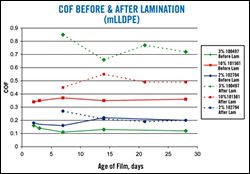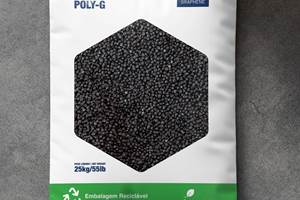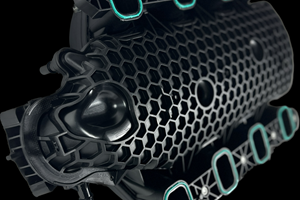Slip Agents: Extended Performance Range for Polyolefin Films
Newer specialty slip masterbatches go beyond traditional capabilities to provide greater thermal stability, reliability, and ability to hold COF steady during laminating.
Today’s slip masterbatch additives for LDPE, LLDPE, and other polyolefin films offer a wider range of performance capabilities than in the past. These products range from the traditional amide slips—the predominant grades now in use—to newer specialty, non-migratory grades that can meet such needs as the ability to work well at higher temperature, improve reliability, and hold coefficient of friction (COF) steady before and after laminating. Processors should be aware of newer alternatives that overcome slips’ previous limitations.
Slip agents overcome the resins’ natural tackiness so they can move smoothly through converting and packaging equipment. LDPE and LLDPE films are commonly categorized as low-, medium-, or high-slip, depending on their COF. The COF level generally corresponds to how much slip they contain (see Table 1).
Slip masterbatches are available in formulations that allow for various diffusion rates, end-use temperatures, base resins, and ink types. Traditional slips are based on unsaturated fatty acid amides, most commonly oleamide and erucamide. These primary amides migrate rapidly through polyolefin films after extrusion and appear on the surface of the film to lower the COF.
Other slips based on secondary amides have almost twice the molecular weight of primary amides and thus migrate more slowly in polyolefins. Traditional primary and secondary amides are offered commercially in LDPE, LLDPE, and mLLDPE carriers.
The newer slip masterbatches include non-migratory slips with very large molecules and specialized formulations adapted for lamination. Specialty grades may be comprised of blends of primary slips or primary and secondary amide slips, as well as a variety of carrier resins such as PP, EMA, and EVA.
Standard migratory slips
Film producers tend to rely on amide slips because they lower COF at a reasonable cost. Primary and secondary amide slips allow processors to select COF’s between 0.1 and 0.4.
Migratory slip concentration in a masterbatch is typically 5% to 10%. Migratory slip concentrations typically range from 200 to 2000 ppm in actual films. Thinner films generally demand higher slip concentrations to attain a given COF. Erucamide is more widely used because it is derived from non-animal sources and tends to be somewhat more thermally stable than oleamide.
Films need a conditioning period after extrusion so that equilibrium can be established between the slip on a film’s surface and that in its interior. Since most of the COF reduction occurs within the first day (Table 2), COF in LDPE and LLDPE films is usually measured 24 hr after extrusion.
The COF and slip migration rate are usually tailored for the end use. Faster slip diffusion is important for in-line forming and converting into bags and other products. Slower slip diffusion is needed for roll stock so that the COF does not fall too quickly and cause winding difficulties and telescoping of rolls.
Migration factors
Many variables influence migration rate and ultimate COF. Diffusion in a polymer is faster with smaller slip molecules and higher concentrations. The nature of the polymer is also important. Slip molecules diffuse mainly through amorphous regions of a polyolefin, so migration is slower in more crystalline resins like HDPE and PP than in LDPE or LLDPE.
Highly amorphous and tacky polymers, such as lower density mLLDPE grades (<0.92 g/cc) require high loadings of slip. Polar polymers like EVA or EMA can interact with the functional groups of a slip and retard its migration.
Migration of slips through polyolefins is slower in a wound roll than an unwound one. The greater the winding tension, the slower the diffusion rates.
Also, antistats and antifogs can compete with slips for surface sites and during diffusion. These additives have larger molecules than primary amide slips, so they migrate more slowly. Some antiblocks may adsorb slip molecules and adversely affect their diffusion.
Downstream processing may also affect COF. For instance, corona treatment prior to printing burns off the surface slip layer and makes the surface polar. As a result, more slip migrates toward the corona-treated side than to the untreated one.
Primary amide slips have thermal limitations. While they work well in blown films processed at 400 F, they tend to volatilize at higher temperatures. They are not suitable for use with cast films, which are typically made at 500 F to 550 F, or in extrusion coating, which is commonly done at 600 F. This also applies to films that must pass over hot metal machine elements.
Secondary amide slips have better thermal performance and are used at higher temperatures. They migrate more slowly than their primary amide counterparts and hence provide better control of COF. They are also less likely to interfere with printing and heat sealing. Secondary amides are sometimes chosen when balancing slip and antiblock properties is critical.
Non-migratory slips
Introduced in the late 1990s, non-migratory slips have molecular weights 30 to 50 times greater than primary and secondary amides. Their large size does not allow them to diffuse through a polymer, so their COF reduction is provided by the slip molecules that end up on the surface during extrusion.
As a result, they need no conditioning period and their lubricity remains relatively steady as a film passes through lamination, converting, printing, shipping, and other steps. The COF they provide also tends to be more uniform across the film than with primary amide slips.
Non-migratory slips typically yield COFs from 0.20 to 0.40, depending on use level (Table 3). Consistency of COF from 15 to 62 days after casting LDPE with a non-migratory slip is shown in Fig. 1.
Unlike migratory slips, these types are only needed in the outer layers of multilayer films. That makes non-migratory slips more cost-effective in multilayer films, even though higher levels (1% to 2%) are required in those outer layers. Non-migratory slips reduce the need to overdose the amount of slip to create a reservoir in the film to allow sufficient migration to the surface. Also, the consistent COF with non-migratory slips eliminates one process variable, which helps reduce rejects during converting.
Non-migratory slips are stable at high temperature and may not adversely affect the heat sealing of a PE film if done at the appropriate temperature. They can also be used in cast films and withstand the elevated temperatures of hot filling, shrink tunnels, and other operations. Films made with non-migratory slips have good seal strength. For in-stance, the seal strength of a 2-mil, two-layer LDPE cast film with a non-migratory slip only in the sealant layer was 2423 psi with addition of 10% slip masterbatch and 2491 psi with 20% slip masterbatch.
Non-migratory slip masterbatches are available with 10% and 20% slip for LLDPE blown films, LDPE cast films and extrusion coatings, and PP cast films. These slips can transfer across film surfaces on tightly wound rolls and they reduce film clarity more than primary or secondary amides.
New for lamination
The COF of polyethylene films containing erucamide slip agent often rises when the films are adhesively laminated to other films. This is believed to occur because erucamide is attracted to the adhesives or to the polar substrates such as PET or nylon used in adhesive lamination.
The slip drawn away from the PE sealant surface can cause the COF to increase to 1.0 or more, which makes film movement more difficult through vertical form-fill-seal, printing, and other converting equipment. The loss of COF is more pronounced in laminated films that sit for a time before being converted or printed.
A recently introduced type of slip can avert this problem by remaining in the PE layer. Thirty-day tests found that one such slip (Ampacet 102794) holds COF steady before and after lamination (Fig. 2). This slip was compared with a conventional erucamide and a non-migratory slip in 2-mil films with a three-layer coextruded structure commonly found in flexible food packaging—mLLDPE seal layer plus two octene-LLDPE layers. The films were laminated to a PET film with a solvent-based polyurethane adhesive.
COF in the samples containing the new slip settled in at 0.2 before and after lamination. COF in the films with the standard erucamide jumped more than five-fold to between 0.68 and 0.85 after lamination, while COF in films with the non-migratory slip rose modestly from about 0.35 to about 0.5.
Experience indicates that the new slip formulation should perform similarly in other film structures, such as coextruded LLDPE films with an EVA sealant layer. Ampacet 102794 is cost-effective because it can be used at a 2% letdown ratio. In addition, it does not need to be overdosed to compensate for slip lost in the sealant layer due to lamination.
Related Content
Resins & Additives for Sustainability in Vehicles, Electronics, Packaging & Medical
Material suppliers have been stepping up with resins and additives for the ‘circular economy,’ ranging from mechanically or chemically recycled to biobased content.
Read MoreGerdau Graphene Launches “First” Graphene-Enhanced PE Additive Masterbatch for Extruded Packaging and More
The company has also partnered with conglomerate Sumitomo Corp. for distribution of its graphene-enhanced masterbatches in Japan.
Read MoreCompatibilizers Aid Recycling & Upcycling of Mixed Resins
Compatibilizers are proving their worth in boosting critical properties such as impact/stiffness balance of PCR and PIR blends of polyolefins and other plastics.
Read MoreBASF Highlighting How They 'Make, Use and Recycle Future Solutions'
NPE2024: BASF is using its proprietary computer-aided engineering tool Ultrasim when designing for sustainability in a broad range of industries.
Read MoreRead Next
For PLASTICS' CEO Seaholm, NPE to Shine Light on Sustainability Successes
With advocacy, communication and sustainability as three main pillars, Seaholm leads a trade association to NPE that ‘is more active today than we have ever been.’
Read MoreMaking the Circular Economy a Reality
Driven by brand owner demands and new worldwide legislation, the entire supply chain is working toward the shift to circularity, with some evidence the circular economy has already begun.
Read MoreLead the Conversation, Change the Conversation
Coverage of single-use plastics can be both misleading and demoralizing. Here are 10 tips for changing the perception of the plastics industry at your company and in your community.
Read More































